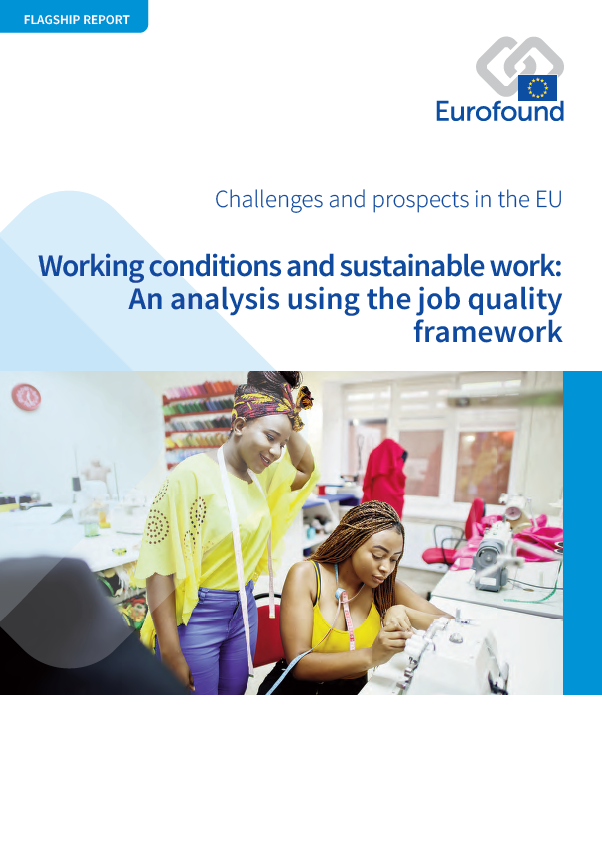
Este informe emblemático resumen las principales conclusiones de la investigación de Eurofound sobre las condiciones de trabajo realizada durante el periodo de programación 2017-2020. En él se describen los avances logrados desde 2000 en el ámbito de la mejora de las condiciones de trabajo y se analiza si todos los trabajadores se han beneficiado por igual del cambio positivo. Asimismo, se destacan los colectivos expuestos a un mayor riesgo de sufrir malas condiciones laborales y quedarse retrasados. También se determinan los retos emergentes para una buena calidad del empleo a la luz de los cambios operados en el mundo del trabajo. El informe también aporta pruebas de las medidas que podrían dar lugar a una mejora adicional del trabajo y a la consecución de unas condiciones de trabajo justas para todos en la UE.
El análisis pone de relieve que, en general, la calidad del empleo en la UE mejora, aunque lentamente. Sin embargo, no todos los trabajadores se están beneficiando de ello en la misma medida. Además, el sexo, la edad y la situación contractual influyen significativamente en las condiciones de trabajo de una persona. Y aunque la digitalización ayuda a abordar algunos problemas relacionados con la calidad del empleo, también genera nuevos retos. La pandemia de COVID-19 ha exacerbado las tendencias, ha intensificado las preocupaciones y ha puesto de manifiesto la importancia de lograr la calidad del empleo para todos.
Key findings
Por término medio, los trabajadores de la UE disfrutan hoy de mejores condiciones laborales que a principios del milenio. La calidad del tiempo de trabajo ha mejorado claramente, pero también el entorno físico es mejor, especialmente donde más importa: en las ocupaciones que presentan una elevada exposición a riesgos físicos.
En la actualidad, los puestos de trabajo requieren mayor cualificación y ofrecen mayor autonomía que en el pasado. Esto se refleja en una mejora del índice de destrezas y capacidad discrecional.
El desarrollo de las destrezas de los trabajadores se ve obstaculizado por la desigualdad en el acceso y la asunción de formación cuyo coste es cubierto por el empleador. Los trabajadores de más edad participan menos en la formación, y existe una brecha creciente en el acceso entre los empleados en distintas situaciones contractuales (a jornada completa frente a jornada parcial y contratos indefinidos frente a temporales).
La persistente segregación por sexos dentro del mercado laboral se refleja en las diferencias en la calidad del empleo entre los hombres y las mujeres. Pero no hay ningún ganador absoluto. Las brechas de género también pueden ir en detrimento de los hombres, por ejemplo, en lo que respecta al entorno físico.
Aunque las perspectivas profesionales han mejorado en general para hombres y mujeres, los hombres han mantenido su ventaja en la dimensión de la calidad del empleo. La causa más probable es el reparto desigual de las responsabilidades relacionadas con los cuidados, que se manifiesta en las interrupciones más prolongadas de la carrera profesional y en los diferentes regímenes de tiempo de trabajo para las mujeres.
Based on the European Working Conditions Survey (EWCS) 2015 analysis, the data below accompany Eurofound's flagship report on working conditions and sustainable work and focus on job quality for different occupational profiles.
- Data: Job quality in the EU
The flagship report also has the following list of tables and figures.
List of tables
Table 1: Change in the composition of the workforce, EU27 and the UK, 2002–2019
Table 2: Elements of the job demands–resources model based on the EWCS
List of figures
Figure 1: The seven dimensions of job quality and the indicators composing each dimension
Figure 2: Indexed change in job quality indices, EU27 and the UK, 2000–2015
Figure 3: Physical environment index: mean and standard deviation, by occupational category, EU27 and the UK, 2000–2015
Figure 4: Work intensity index: mean and standard deviation, by sector, EU27 and the UK, 2000–2015
Figure 5: Work intensity index: mean and standard deviation, by country cluster, EU27 and the UK, 2000–2015
Figure 6: Skills and discretion index: mean and standard deviation, by occupational category, EU27 and the UK, 2000–2015
Figure 7: Skills and discretion index: mean and standard deviation, by country cluster, EU27 and the UK, 2000–2015
Figure 8: Participation in paid training (%), by employment and contractual status, EU27 and the UK, 2005–2015
Figure 9: Associations between working time quality and occupational category, by country cluster
Figure 10: Working time quality index: mean and standard deviation, by country cluster, EU27 and the UK, 2000–2015
Figure 11: Long working hours (%), by employment status, EU27 and the UK, 2000–2015
Figure 12: Prospects index: mean and standard deviation, by occupational category, EU27 and the UK, 2005–2015
Figure 13: Prospects index: mean and standard deviation, by country cluster, EU27 and the UK, 2005–2015
Figure 14: Scores on Prospects index, by employment and sociodemographic characteristics, EU27 and the UK, 2005 and 2015
Figure 15: Receipt of support from colleagues and managers (%), EU27 and the UK, 2005–2015
Figure 16: Receipt of support from colleagues and managers (%), by age group, EU27 and the UK, 2005 and 2015
Figure 17: Exposure to adverse social behaviour (%), by gender, EU27 and the UK, 2010 and 2015
Figure 18: Perception of fair pay (%), by Member State and the UK, 2005–2015
Figure 19: Perceived appropriateness of pay, by country cluster, EU27 and the UK, 2005–2015
Figure 20: Job quality profiles: Scores on seven job quality indices, EU27 and the UK, 2015
Figure 21: Distribution of workers according to job quality profiles, EU27 and the UK, 2015
Figure 22: Job quality profiles of men, by job quality indices, EU27 and the UK, 2015
Figure 23: Job quality profiles of women, by job quality indices, EU27 and the UK, 2015
Figure 24: Distribution of employees according to predominant gender in occupation (%), by gender, EU27 and the UK, 2010 and 2015
Figure 25: Gender of immediate manager (%), by worker’s gender, EU27 and the UK, 2005–2015
Figure 26: Female employees reporting good prospects for career advancement and gender gap (%), EU27 and the UK, 2005–2015
Figure 27: Good prospects for career advancement (%), by age and gender, EU27 and the UK, 2005–2015
Figure 28: Job insecurity according to predominant gender in occupation (%), by gender, EU27 and the UK, 2010 and 2015
Figure 29: Employability according to predominant gender in occupation (%), by gender, EU27 and the UK, 2010 and 2015
Figure 30: Employees reporting difficulty making ends meet according to occupation type (%), by gender, EU27 and the UK, 2015
Figure 31: Employees reporting difficulty making ends meet according to household type (%), by gender, EU27 and the UK, 2015
Figure 32: Employee experience of selected emotional demands (%), by gender, EU27 and the UK, 2010 and 2015
Figure 33: Average weekly working hours of employees across the life course, by gender, EU27 and the UK, 2015
Figure 34: Flexibility to take time off according to predominant gender in occupation (%), by gender, EU27 and the UK, 2010 and 2015
Figure 35: Additional components of earnings from main job (%), by gender, EU27 and the UK, 2005–2015
Figure 36: Employees’ perception of their work–life balance (%), by age, EU27 and the UK, 2015
Figure 37: Employees’ participation in training (%), by age and training classification, EU27 and the UK, 2015
Figure 38: Associations between demands and resources and workers’ health and well-being
Figure 39: Proportion of workers with flexitime schedules and engaged in TICTM (%), EU27 and the UK, 2015
Figure 40: Workers reporting work–life balance problems (%), by work arrangement and presence or absence of children, EU27 and the UK, 2015
Figure 41: Multiple-job holders as a proportion of total employment (%), by gender and country, EU27 and the UK, 2018
Figure 42: Job quality profiles of multiple-job holders’ main jobs, by gender, EU27 and the UK, 2015
Figure 43: Job quality of selected critical occupations in relation to the workforce average
Figure 44: Emotional demands on ISWs and extent of those demands (%), EU27 and the UK, 2015
- Number of pages
-
80
- Reference nº
-
EF20021
- ISBN
-
978-92-897-2150-9
- Catalogue nº
-
TJ-03-21-030-EN-N
- DOI
-
10.2806/938302
- Permalink
Members of Eurofound’s Management Board provide their reactions to and insights into Eurofound’s 2021 flagship report on Working conditions and sustainable work: An analysis using the job quality framework.
- Impact of the Covid-19 pandemic
Interview with Juha Antila, Head of Research and Development SAK, Central Organisation of Finnish Trade Unions.
- Digitalisation
Interview with Mario van Mierlo, Deputy Director, Social Affairs, The Dutch Confederation of Industry and Employers (VNO-NCW).
- Making work sustainable
Interview with Alain Piette, Ergonomist at the Belgian Federal Public Service Employment, Labour and Social Dialogue.
- Role of different actors in improving job quality
Interview with Rebekah Smith, Deputy Director for Social Affairs, BusinessEurope.
- Persisting challenges
Interview with Nelson Ferreira, Deputy General Inspector ACT, Portugal Labour Conditions Authority.
- Remote working
Interview with Esther Lynch, Deputy General Secretary of the European Trade Union Confederation (ETUC).
Cite this publication
Eurofound (2021), Working conditions and sustainable work: An analysis using the job quality framework, Challenges and prospects in the EU series, Publications Office of the European Union, Luxembourg.
